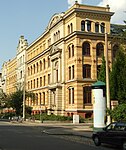Alter Johannisfriedhof

The Alter Johannisfriedhof ("Old St. John's Cemetery") is the oldest burial ground in the city of Leipzig, Germany. It began in 1278, as part of the Johannishospital (St. John's Hospital) in Leipzig, a leper hospital. It was later attached to the Johanniskirche (St. John's Church), which was destroyed in World War II. In 1536 it became the common burial ground for the city of Leipzig, and expanded several times. It was also re-modeled in the style of the Camposanto in Pisa, a popular style of cemetery in Germany. In 1680 and 1805 the graveyard was expanded by the additions of sections three and four respectively, then the fifth and the final extension took place between 1827 and 1863. 1883 saw its last burial. In 1981 the graveyard was closed and comprehensively cleared. Fifty-eight monuments and gravestones from the former Neuer Johannisfriedhof, which had similarly been cleared and re-developed as the present Friedenspark, were set up in the south-eastern corner of the Alter Johannisfriedhof. Since 1995 the former burial ground has again been accessible to the public, and is a protected monument as a museum and park.
Excerpt from the Wikipedia article Alter Johannisfriedhof (License: CC BY-SA 3.0, Authors, Images).Alter Johannisfriedhof
Johannisplatz, Leipzig Southeast center (Mitte)
Geographical coordinates (GPS) Address Phone number Website Nearby Places Show on map
Geographical coordinates (GPS)
| Latitude | Longitude |
|---|---|
| N 51.336944444444 ° | E 12.389444444444 ° |
Address
Grassimuseum
Johannisplatz 5-11
04103 Leipzig, Southeast center (Mitte)
Saxony, Germany
Open on Google Maps











